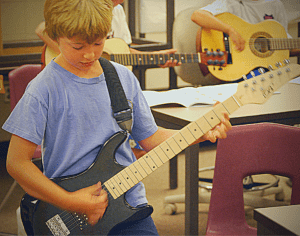What kind of guitar should I buy for my child?
The most common question we receive from parents who are looking into starting their child on guitar lessons is “What kind of guitar should I buy for my child?”. We are going to address this in-depth, but before that, let’s take a minute to talk about why guitar is a great instrument for young musicians.
Guitar is a solid choice for burgeoning musicians because:
- Guitar is accessible. You can find them in multiple locations in many communities.
- Guitars are inexpensive. A flute could cost $1,000+ dollars. A piano…even more. A starter guitar can be found for around $150-200.
- Guitars are mobile. Guitars fit into a handy carrying case, many with shoulder straps to wear like a backpack.
- Guitars are great for singers. If a child wants to play an instrument and sing at the same time, guitar is a great instrument. Thousands of songs have been written by singer-guitarists.
- Guitarists are often self-taught. Although I’m not a huge advocate for students to teach themselves how to play an instrument, guitar has a history of guitarists who have taught themselves. With the recent passing of maestro Eddie Van Halen, we are reminded that brilliant and innovative musical minds can learn so much music by persistence and dedication.
- Guitar is cool! Let’s face it, everyone looks better with a guitar around their shoulder. It’s iconic.
Okay, now that I’ve thoroughly convinced you of why to choose guitar…now let’s talk about what guitar to choose.
1. Do you own one already?
The first question I ask parents is, “Do you own a guitar or does anyone you know own a guitar already?” Why? Money! Although a new guitar is quite affordable, if you don’t have to spend money, why do it. If a parent has a slightly dusty guitar that maybe just needs some new strings, why not spend $20 an getting and changing to new strings rather than $150 or more on a new guitar.
If changing the strings on an older guitar, we recommend lighter gauge strings which are easier on children’s fingers.
A caveat you’ll see me add in a few more places below is, if a child is not inspired to play guitar using Uncle Don’s guitar from 1979, then it might be a better choice just to get a new one. If $150-200 gets your child more interested in learning music, it’s money well spent.

Young Guitarist
2. Buy a youth size (3/4 size) guitar.
If your new musician is 12 years old or younger, a 3/4 size guitar is a better choice. 1) It fits better under their arm; 2) It is easier to fret chords (especially the G-chord); 3) It is more comfortable for a young guitarist.
If your child is 13 or older, it really depends on the size of guitar that is most comfortable for them. Some guitars, like Ovation, feature more narrow necks making it easier to fret chords for smaller hands. Others, like Godin, feature much wider necks which are more comfortable for adult musicians with larger hands.
2.1. Buy a guitar with nylon strings, also referred to as a “classical guitar”.

Classical Guitar
Nylon strings are very good for young fingers. They are easier to hold down and keep a good tone and they don’t create callouses to the level that steel string acoustic guitars do.
For my 10 year old daughter, I purchased a Cordoba Protege for $189 (https://www.guitarcenter.com/Cordoba/Protege-C1-3-4-Size-Classical-Guitar-Natural-1364498730600.gc). She loves it. It sounds so good, it keeps its tune for days on end and she runs to play it many days of the week.
NOTE: We reference Guitar Center often in this blog, but there are many guitar stores online (https://www.sweetwater.com/) and many storefronts in communities that sell guitars. We recommend going into a store and holding the guitar to get a feel for what is best.
2.2. Acoustic, steel string guitars

Acoustic, steel string guitar
Steel string acoustic guitars are likely the most popular in the world. They are used in folk music, country music, blue grass, rock and roll, praise music, and popular music. You can hear them on recordings for commercials, video games, and even movie trailers.
Your child might prefer this type of guitar due to that popularity and if it will inspire them to play more and become a better musician, we say, “Go for it!”
If your child wants an acoustic guitar we highly recommend light gauge strings. Light gauge strings are easier on children’s fingers, but wear out faster and aren’t quit as loud. The payoff of being easier for children vastly outweighs the volume and shorter lifespan.
2.3. Electric Guitars

Electric Guitar
The amplified volume, the slick feel and the history of absolute coolness is hard to argue with for electric guitars. If an electric guitar is what is going to keep your child “into” music, then get it. No regrets!
A few factors to consider are
- Price – Electric guitars have more components and thus a starter electric guitar is more expensive. A starter set could be around $200 (https://www.guitarcenter.com/search?typeAheadSuggestion=true&typeAheadRedirect=true&fromRecentHistory=false&Ntt=electric+guitar+starter+package)
- Extras – You will need an amplifier and at least one chord to plug the guitar into the amplifier. Any sales person at any guitar store could easily outfit you with what you need.
- Volume – It’s fun to play loud and fast. Really fun! Is your household prepared for that?
That being said, electric guitars are super fun, and the cool factor is heavily in its favor.
3. Don’t go cheap
First Act guitars are good guitars to get really young players hands on an instrument. However, at $50-ish, you get what you pay for. Guitars that are priced at $100 or less are often lacking in basic needs of any guitarist.
- They fall out of tune almost immediately.
- The strings are poorly structured and difficult to play.
- The frets aren’t constructed correctly, so playing anything beyond the third fret is out of tune, even if you’ve just tuned the guitar.
- They sound awful!
You and your child will be better served spending $150-250 on a starter 3/4 sized nylon string, steel string, or electric guitar.
4. Other items
Guitar tuners come in all types and sizes. Some clip on to the head of the guitar, some are digital apps for your phone, some plug into the electric guitar. As your child matures as a musician, they may eventually be able to tune by ear or with another instrument. However, most guitarists use a tuner often.
Here’s a clip on one we like for sale at Amazon.com: Guitar Tuner
Also a guitar stand is very handy. You need someplace to keep your guitar, so getting a guitar stand is a necessary first purchase.
You may also want to purchase a book of popular tunes your child wants to learn
6. What’s Next?
We mentioned earlier that many guitarists are self-taught. I’ve gone back and forth for decades between taking lessons and learning on my own. There are tons of videos and websites online to help new guitarists. However, what if they get stuck? What if they aren’t learning properly? What if they lose interest?
There is a place for self-learning, but at the very beginning of the process, that approach is tricky. We recommend that you reach out to your local music studio, do a Google search on “guitar teachers near me” or sign up for YEL classes.
YEL offers online group guitar lessons, private lessons, and in-person group lessons. All of our options feature, expert coaches, robust curriculum, and a nurturing environment for budding musicians.
You can find all of our options by clicking REGISTER and searching for classes near you.
If you don’t see any classes in your area, reach out to us and we’ll see what we can do to start programs at your school.
FRANCHISING – YEL is offering franchise opportunities in 37 states. CLICK HERE to find out more about owning your own YEL Franchise. We’d love a caring and dedicated local leader to head up our programs.
[simple-author-box]




 ©2018 YEL
©2018 YEL ©2020 YEL
©2020 YEL

 ©2019 YEL
©2019 YEL

 2019
2019